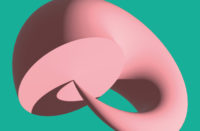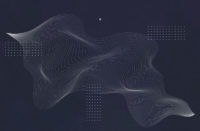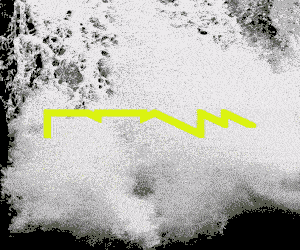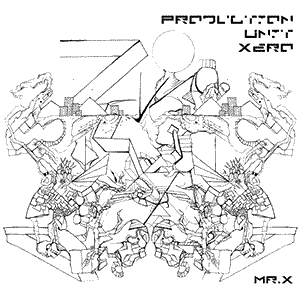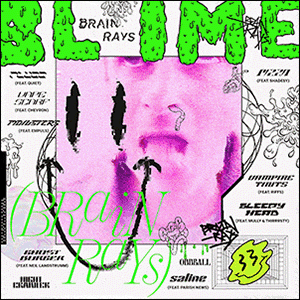
(12.12.05) LIKE-MINDED :: Non Visual Objects (NVO) is a small recording label based in Austria and operated by sound sculptor Heribert Friedl and Raphael Moser. Their initial three offerings have a strong minimalist slant and include work by Steve Roden, Roel Meelkop and Friedl himself. In the works are offerings by Richard Chartier, Bernhard Gunter/Friedl and a quartet collaboration, all of which we took some time to chat about when I caught up with him at home in Vienna.
::..:::…..:..::….:::::..:::..:::::::……:::…::.:::….::::..:..:::…::…….:::::
TJ Norris :: Hello Heribert, how is Autumn treating you?
Heribert Friedl :: Autumn is my favorite time of the year. Especially this year it was really long and intense too. Beautiful colors and light, clear air and mild temperatures. Autumn is always the beginning of an intense working period for me. A good time to retreat and focus on the essence. So in this sense autumn is really treating me good.
TJN :: Ahhhhh, totally refreshing time, yes, the Fall always seems like creative renewal to me! Speaking of, a new label is very exciting, and your first three simultaneous releases are a great indication that minimalism is your primary color. How do you respond?
HF :: Yes, definitely! Especially in visual arts, American minimalism has had a big influence on me. I see my roots more in that area than in my local area (for example “Wiener Aktionismus”). Raphael also definitely has a minimal background. Parallel to NVO we have the ongoing project GRAT (www.grat.org), that was originally intended to be a CD label, but then turned into more of a visual arts project. Raphael and I initiated that together with Margit Hartnagel in 2000.

TJN :: Well, that’s creative evolution, change leads to new ventures. Do you refer to yourself as a sound artist, composer or musician? And as such, do you see NVO as a jumping off point to showcase your own work in context with others doing similar things with sound?
HF :: Music has always been a constant companion in my artwork. The valences always shifted. Although I studied sculpture, music has always been present. I don’t really want to place myself in one category. It is always about the work itself. If there is a composer, a musician or a visual artist behind the work is secondary. At the moment I am working with sound material, so it is obvious to associate myself to a musical context.
The idea of starting our own label has been around for a while. Unfortunately there is not much tradition of this kind of music here in Vienna, accordingly to a few people that I deal with. Raphael, who had lived in Tokyo for several years and at that time started to really get into and deal with this kind of music, then forced the idea of starting a label. It is mostly about getting people together that work on similar ideas, to build a community of like-minded people. For that the internet is of course a great thing. You are not attached to a certain place and are able to communicate globally. We just want to release music that we think has something to offer and we feel needs to get a chance to be presented properly. No matter what the musician’s background. The product is what counts in the end.
TJN :: So, you will be a altruistic pioneer of sorts in your own world. In creating the roster for NVO, do you see yourself as a curator, so to speak? And how is Raphael Moser involved in the process?
HF :: We run the label together. That means all decisions are made collaboratively. Since we have a very similar idea of art, there are hardly any differences in the process. All works are dealt with separately and each of us then gives his opinion. The result is almost always unanimous. Raphael also does the graphics for the label. Well, Territorium, I kind of curated, since there was a thematic idea for it, but otherwise it is more of a sorting out.
TJN :: Talk about aesthetics. The label, cover art, etc.
HF :: There is a certain aesthetic approach for NVO. We try to use the material economically and precise. The cover should not only physically protect and illustrate the music, but stand on its own as an artwork. With the packaging and the limited/hand-numbered edition we try give it the character of an object of art. By using high quality paper and 4-color print we want to give people the feeling of buying a professional product.
TJN :: And you most certainly do, the finished release has a definitive style, fanciful, yet austere.
How did the name NVO come about, will you in some way fuse what you do in the visual arts, installation, et al? I have noticed that despite the label name (the brand) that may infer only sound, that at least a few of your current releases (Meelkop and Roden) as well as those upcoming (Richard Chartier) actually feature visual artists and/or graphic designers. Can you talk about that some, or is it coincidence?
HF :: I first used the term nonvisualobjects in 1996 for an exhibition. I installed 10 ventilators in a sill. The sculpture was not only the actual object, the ventilators, but also the wind and the sound of the wind. I was talking about sculpture, but meant the annulment of matter. The object was there, just not visually perceptive. You could feel and hear the work, it incorporated the body of the viewer and personified itself as an invisible phenomenon. It is a matter of approaching the subject matter. Nothing is concluded nor excluded as priori.
TJN :: In my attempt to describe the impact of your vision: Sparsely ambient, fragmentary, fields of pure sound. The work casts shadows, laying a chalky patchwork of imaginative ambience. NVO generates something aurally tactile, in various organic layers of geometries and textures. How about that?
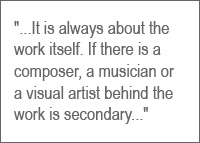
HF :: Well, that is probably because after all I am a trained sculptor. The use of material is a way of molding. You try to find a form and get rid of unneeded ballast. The approach to Raumzitate was actually a clearly conceptual one where my immediate surroundings were processed. Hardly audible sounds were macroscopically analyzed, dissected, edited and looped endlessly as a quotation.
Working on Ataraxia with Bernhard Guenter is much more orientated on composing and improvising, whereas Bradycard actually goes back to the beginning and tradition of my musical work. It is sort of working off of a history of myself. The working method is the same up to now, sound is analyzed and then combined. The software is not and never should be the message.
TJN :: Technology is only a tool. Can you say some about your own evolution? Some of the work you have done and maybe, since it’s the season, some of your favorite things…
HF :: Like I mentioned, I come from a visual art context. I studied sculpture at the University of Applied Arts in Vienna. I was first concretely confronted music at the age of six. During my time at school I also attended a musical school, where I first studied flute and then up to the age of 14, the Hackbrett. Afterwards I studied classical guitar. So music has always accompanied my visual art.
I took part in exhibitions in many countries. One of my favorite works was realized at the Museum Folkwang (Essen, Germany). It was an empty room you could enter from two sides. Only the walls were painted with scent substance that you could scratch and smell. Even though the room was completely empty, visually speaking, it was plumply filled with the scent.
TJN :: Wow, I love the whole rationale behind odorama! John Waters turned me on to that many moons ago with his kookie film Polyester, and I subsequently curated a few multi-sensory exhibitions, but the idea of actually painting with scents is really a unique way of working, and having your audience participate!
Regarding NVO, with such a distinct, honed cast of artists will your label host performances related to the releases, or other like events something like a label showcase at a music festival?
HF :: At the moment we are working on creating a platform for like-minded people. Working on the label continuing to release quality work, that is the priority now. Everything else we will see in the future, but of course we are also interested in organizing live events.
TJN :: I will watch for that. And, obviously there are other like small labels releasing and distributing in limited editions, even some like Spekk (Japan), 12K (US) and Raster-Noton (Germany) to name a few. How will NVO differ in terms of throwing your hat into the ring?
HF :: I think the mentioned labels basically all work on the same thing. It’s the details that differentiate them. Raster-Noton, 12k and not to forget Trente Oiseaux (10 years!) have been important for the scene for years. It is hard to imagine the scene without them. They have been pioneers. The scene is rather small but globally very well networked. Many musicians have worked for and with each other. It is giving and taking in a way. Everybody tries to explore new territories. Positioning the label at certain place/city is not really relevant any more, building up a small label like NVO now works on a global level. Even though the mentioned labels all work in a “minimal context,” they explore different fields. We are interested in any form of minimalism, digital, electro-acoustic or based on field recordings is secondary. There is still a lot to discover and we hope to contribute to that, to release new and interesting material.
TJN :: So, are you saying that cultural regionalism has been completely lost in the techno age? Or the sense of cultural place has lost its impact to convey the eccentricities of its locals, its natives? Have traditions dried up? Or is there some universal voice of minimalism? Is it a language unto itself, breaking barriers and axis’?
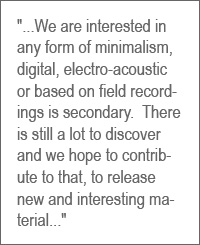
HF :: NVO could happen anywhere, but since our base is Vienna we work from here. NVO is also not to be seen as a regional development aid, it is just a part of the lot. Since the city is rather small it isn’t relevant to establish our own scene. As one can see 12k, Raster-Noton and Spekk are all over the globe, focusing on one idea, with differences of course. Minor influences of regional cultures can be found here and there but nothing you could call explicitly regional. Yes, therefore you can probably say it is a universal language of minimalism.
TJN :: Can you talk about the choice for running a small run label, and maybe some about the potential audience. Is starting a label such as this a pure labor of love, since the return on investment is not about dollars, obviously. Maybe you can comment on the art for art sake aspect of running a business/label with such an intent.
HF :: The idea of running a label has existed for quite a while. Since there is not that much interest for this kind of music here in Vienna we just did it ourselves. Of course running a small label is not “Big Business,” and that is not our idea behind it, but we also have to survive financially. Like I said, it is more about building a platform for like-minded people.
TJN :: So, how do you think, in any way, will your steps bring more of an interest to some audience in Vienna? What are the general public listening to there these days? Will you try to involve those near as well as those far? Is building a community in your own area of any special importance to you?
HF :: There is a tradition in electronic music here in Vienna and some of the labels have existed for many years. The scene is quite diverse, but in the area NVO is now working, we think nothing had really existed before. There is no label here in Vienna that releases our kind of music. Mego, Charhizma, Durian, and now Mosz are all labels that have their own field and their own small communities. Of course we try to be a contact point in our field of music but it is not primary in establishing ourselves here in Vienna.
TJN :: It’s been a pleasure chatting with you. Your voice is very welcome to the larger community. Any final words?
HF :: We would like to thank everybody for the worldwide support and hope we can continue to release quality and surprise people. And of course thank you TJ for doing this interview!
::..:::…..:..::….:::::..:::..:::::::……:::…::.:::….::::..:..:::…::…….:::::






